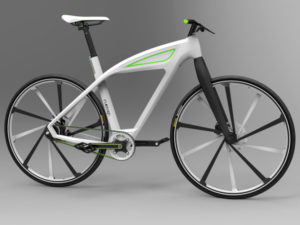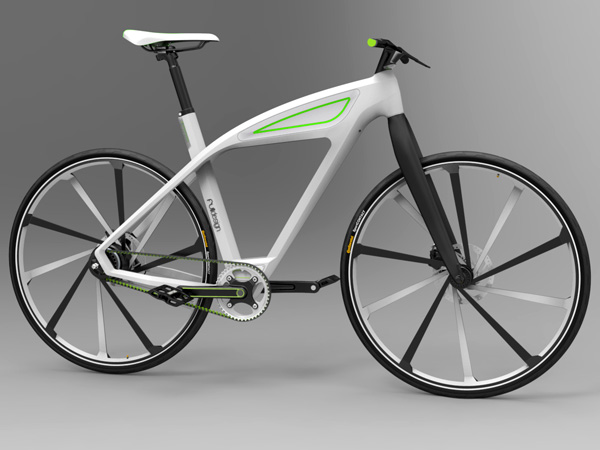The Electric Bike of the Future Will be Social, Smart, Entertaining, & Talking to Traffic All The Time
This is a guest post from Edward Benjamin, Senior Managing Director of eCycleElectric LLC, and Chairman of Light Electric Vehicle Association (LEVA).
For nearly 20 years, I have watched engineers, inventors and designers steadily improving electric powered two wheelers. Improving performance, reliability, and appearance in nearly every aspect in every market.
Some of the electric bikes of today are truly marvelous. We have inexpensive bikes that successfully carry many millions of people to work every day. We have electric mountain bikes that carry the rider uphill effortlessly. We have stylish bikes that turn heads everywhere. We have casual fun styles, and we have severe macho bikes. Some bikes go very, very fast. Some go very far. A few do both.
All of this was hard to imagine 10 years ago. And only 15 years ago we celebrated a few ebikes that actually worked properly out of the box as worthy of praise. Today, ebikes are very reliable.
Electric two wheelers have reached an important point in their development. Most of them are reliable, perform well, and are appropriately priced. Service is available, and the market is solid and growing. Something like cellular phones in the mid 90’s.
So what is the future of such vehicles?
First…ebikes, escooters, emotorcycles, and their battery powered two or three wheeled kin are a success, and will prosper. This is no longer in question.
And it is important to remember that while we think in terms of electric bikes, electric motorcycles and electric motor scooters today – there are new electric vehicles being introduced such as the Segway, self balancing unicycles, Trikke, and others that are so new we do not have vocabulary to describe them. These will be an ever more important part of the market. But they are all light electric vehicles and kin to electric bicycles and other electric two wheelers.
eCycleElectric and other research firms are predicting sales of 120 million or more units per year, in the not very distant future. A fleet of more than a billion electric two wheelers in everyday use is not far off.
Most of those vehicles will carry denizens of densely populated cities to their errands, to the metro or train station, or the bus stop. They will be needed due to traffic and parking congestion that makes such electric two wheelers (as well as normal, manual, bicycles) necessary. Air and noise pollution will add to the urgent adoption of such vehicles.
But that is similar to saying in the mid 1990’s that the cellular phone had evolved to the point where most human beings would soon use one. Do you remember that? It seemed a miracle that you could carry a phone in your pocket that would allow people to reach you (and you to reach them) anywhere in the …world! And they were reliable, had adequate battery life, had become inexpensive and easy to use.
In the 1990’s we could not see the future of smart phones, with constant access to the Internet, social media, on line movies, Siri, and that more people would be texting than talking. The idea of watching a TV show on one’s phone, or locating a stolen / lost phone in moments would have seemed impossible. Having the huge library / encyclopedia of Google accessible all the time, in moments, was inconceivable.
We are at a similar point with electric bikes. So far, our engineers and designers have focused on the utility of the electric bike. How fast, how far, how reliable, and how good looking have been the areas of interest.
But this is very much like having a good flip phone in 1999, and thinking that was the ultimate phone – forever.
We have not seen the end of improvement in utility. Batteries in particular have room for improvement. Motors will become even more efficient. The bikes will become even more beautiful. And just like a Toyota – they will rarely need service attention. Rolling resistance and aerodynamics will become important areas for improvement.
However, the bikes of the future will be far more interesting in the way they interact with traffic, with the user, and with other riders.
We are on the cusp of a time when almost all vehicles will be “talking” to each other while on the road. Combined with radar and GPS, vehicles will be avoiding collisions, staying out of each other’s way, making the best choices for traffic congestion and route – all with minimal input from the human operator. Some will not have a human operator, or the operator will be texting and watching a movie rather than driving.
Cars hitting bicycles will diminish. The bike and the car will be sharing data on their mutual locations, changing course, and applying the brakes. Coaching the driver to avoid any vehicular accidents. Fewer miles will be traveled due to more efficient trip planning that will incorporate weather, traffic, road conditions, state of charge information and more.
Vehicle operators will be less likely to hit the horn and more likely to upload a comment to criticize bad drivers or other problems. A flagrant violator of road laws will become infamous in hours. Detained shortly afterwards as camera and GPS data from hundreds of other vehicles uploads to provide evidence of misbehavior.
An accident will be reported, with data from g meters, GPS, and telemetry on the human operators condition, within seconds of an accident occurring. Emergency response may be even faster as vehicles will be informed of oncoming emergency vehicles long before the siren can be heard.
A casual rider may be interested in which friends are in the area, on the same road or path, and perhaps at a favored destination. Such information will be available, upon approval by the friends.
Engineers at the factory will be able to monitor the condition and actual usage of their products. A bad component will be detected long before it affects most users and recalls can be arranged via the bikes user interface. “Walk Home” events will become very rare. Even a flat tire will be reported to both the user and the service center with the same speed that an accident will be reported. A service vehicle may be following the rider before he is aware of the need for a flat tire repair. (But it is possible that flat tires will also be a thing of the past as flat free tires are rapidly improving.)
Using detailed data on exactly what consumers are doing with the bikes, engineers and designers will be able to rapidly focus and improve on the features that are most important to ebike users. Users will be amazed at how brands and engineers are solving problems the user did not know they had.
User interface will likely progress from today’s screens mounted on the handlebars through heads up displays similar to Google Glass to heads up displays projected in front of the user’s eyes that do not require glasses. Voice commands will replace switches and buttons. Voice reporting will be an option on speed, state of charge, and more. Vehicles will recognize their owners, and refuse to be stolen.
Safety will be further enhanced by air bag like collision systems that will inflate around the rider. These will supplement inter-vehicle communication and running / brake lights that even in daytime cannot be ignored.
Weather protection will come from inflatable enclosures that deploy as needed and depend on air pressure for support. These will create both weather protection and aerodynamic improvements – allowing more efficient use of vehicle energy and higher speeds.
And the user interface system, quite sophisticated, will also add entertainment. The voice of the bike, the “personality” of the bike, and the style of graphic interface will be customized for the user. If your bicycle is, in your fantasies, a WWII fighter plane, it can speak to you in a British air controller’s clipped tones and vocabulary. And display your information as though you were in a holographic cockpit.
Seem incredible? Imagine trying to describe your smartphone and how you use it with social media, and the internet, to someone who just bought their first Nokia with a NiMH battery in 1996.
End of guest post by Edward Benjamin.
Thanks to Edward Benjamin for his forecast of the future of electric bikes. Edward is Senior Managing Director of eCycleElectric LLC, and Chairman of Light Electric Vehicle Association (LEVA).
P.S. Don’t forget to join the Electric Bike Report community for updates from the electric bike world, plus ebike riding and maintenance tips!





Hats off to Ed for this inspiring article. As a 6-year veteran of the ebike industry, like many others I share Ed’s vision of the future and see similar advances and mainstream acceptance and adoption of ebikes forthcoming at an accelerating rate.
All of us in the ebike business–whether in North America or globally–owe Ed a debt of gratitude for his tireless service to bring ebikes to the forefront of alternative transportation.
Thank you Ed and LEVA team. Keep up the great work.
I find the article by Edward Benjamin very interesting and exciting. I’m so glad I am able to be watching this new era evolve. I have always enjoyed the Electric Bike Report and keeping up with the new technology that is happening with regard to this form of personal transportation. Keep up the good work Pete.
Thanks Blaine!
What bike is displayed in this report?
Hi James, it’s called the Ecycle. It is just a concept bike at this point. Here is more info: https://www.yankodesign.com/2013/04/02/ecycle-for-a-greener-world/
Ed Benjamin has great insight into the future of E-Bikes. Its going to be an electrifying ride.